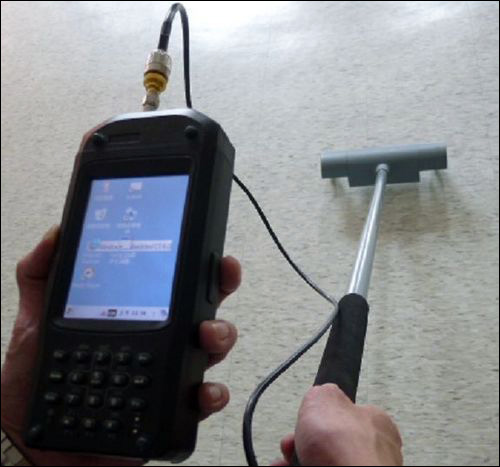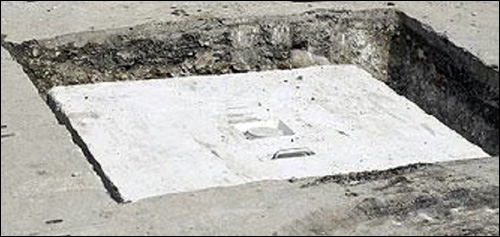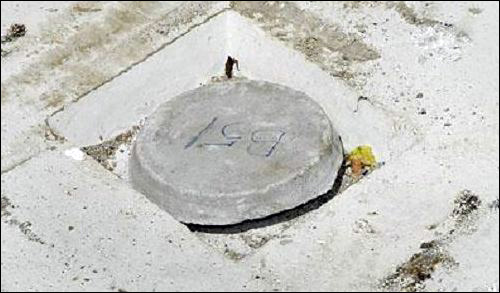When motorized scooters pass over the streets of Taipei—there are more than four million scooters currently in use within the city—they no longer encounter as many metal manhole covers as they used to. Instead, city workers are replacing metal disks (which pose a potential hazard to scooters, bicycles and cars) with cement slabs buried beneath the road’s surface, and are using radio frequency identification technology to locate those manholes at a later date, when necessary. Approximately 20 percent of Taipei’s manholes have been paved over since the project began in 2009. The goal of the Taiwanese federal government is to replace all metal manhole covers across the entire island with buried versions made of cement, and to include an RFID tag with each cover, to be read when necessary by road or utility workers using handheld readers. Initially, the task is being performed by road-works companies for the city of Taipei, which aims to pave over all of its manholes as part of the national program.
The project consists of RFID tags designed for the application and provided by EPC Solutions Taiwan, along with handheld readers to be used by road or utility workers. It also includes software, residing on the city’s server, that manages RFID read data and stores each manhole’s GPS coordinates, as well as its tag’s unique ID number, to be viewed by staff members. So far, approximately 35,000 of Taipei’s 175,000 manholes now have buried RFID-enabled covers.
According to the Taiwan Ministry of Transportation Department, the nation has nearly 2.4 million manholes on its public roads, averaging one every 20 meters (65.6 feet) within cities, and one every 40 meters (131 feet) within rural areas. The department’s statistics indicate that in 2008, the quality of the roadway—which can include the slick, uneven surface created by metal manholes—contributed to 17.3 accidents per month. In 2009, Taipei was the first Taiwanese city to launch a system intended to address this problem. The aim is to produce a smooth, even road surface with no exposed metal manhole covers that can create breaks in the asphalt and pose a slippery surface causing tires to slide. To accomplish this goal, the city needed to pave over the manholes. However, when utility workers need to access the holes, they must be able to find them, and that requires RFID technology.
The city had several requirements. It needed an RFID tag that could be read through the road’s surface, and that would pose no environmental hazard. Moreover, the city rejected the idea of a system that employed RFID readers installed on vehicles to accomplish the reads, and did not want its workers to have to bend over the road to bring the handheld interrogator close enough to read the tags. Therefore, EPC Solutions Taiwan designed an external reader antenna in the form of a wand long enough that workers could plug it into a handheld device and walk over the road without bending over, interrogating any tags embedded beneath the surface.
EPC Solutions Taiwan also designed a passive ultrahigh-frequency (UHF) EPC RFID tag made with an Alien Technology Higgs-3 chip and encased in cement. The tag measures 15 centimeters (5.9 inches) in diameter and 2 centimeters (0.9 inch) in thickness.
With each installation, road workers first chisel down the top of the manhole entrance to 40 centimeters (15.7 inches) below the road surface, and place a cement slab over the hole. The workers then take a cement-encased RFID tag and use a Quintet Digital C35 handheld computer to read the unique ID number encoded to that tag. The C35 unit also records the tag’s location, thanks to the handheld’s built-in GPS module. Next, workers place the tag on the center of the cement slab, after which they bury that slab and the tag in concrete, topped by a layer of smooth asphalt.

The handheld is then returned to the office, where the RFID number and GPS coordinates are uploaded into the EPC Solutions Taiwan software, residing on the city’s server. When employees need to access a manhole at a later date, they walk along the road surface in the general vicinity—based on GPS coordinates associated with that specific manhole—carrying a Quintet C35 handheld computer equipped with EPC Solutions Taiwan’s wand antenna. Once the handheld captures the tag’s unique ID, it displays that data on its screen. Workers then know exactly where to break through the road in order to access that particular manhole.
To date, the tag-reading process has gone well, according to T.H. Liu, EPC Solutions Taiwan’s president, though there have been some challenges in ensuring a read in the presence of concrete and asphalt, as well as water. Currently, he says, the handheld and wand can interrogate tags at a depth up to 60 centimeters (23.6 inches). But in some cases, Liu adds, the city requires tags to be buried as deep as 1 meter (3.3 feet), in order to accommodate pipes. “We are still working on this,” he states, to provide a tag that can be read at that distance through asphalt and concrete and, in some cases, water carried in pipes. Reading tags on rainy days, when the road surface is wet, has proven difficult as well, Liu notes, so workers typically do so only on dry days.



